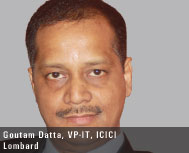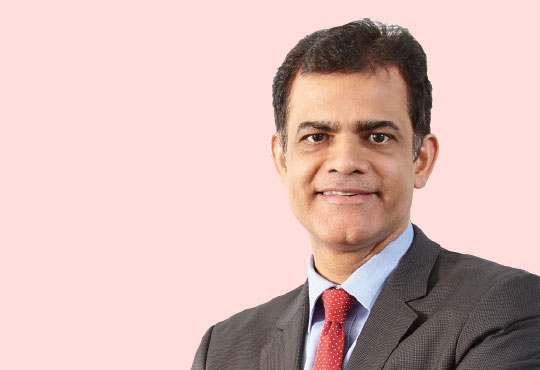
CIOTechOutlook >> Magazine >> September - 2016 issue
Biometric Identification - A Promising Concept in the Financial Industry
By
 With more than 16 years of experience in strategizing, spearheading large-scale technology operations and contributing in transformation of business processes with implementing new technology, Goutam Datta manages internal as well as external partner relationship for critical technology delivery. Goutam is presently the CIO for ICICI Lombard GIC LTD.
With more than 16 years of experience in strategizing, spearheading large-scale technology operations and contributing in transformation of business processes with implementing new technology, Goutam Datta manages internal as well as external partner relationship for critical technology delivery. Goutam is presently the CIO for ICICI Lombard GIC LTD.With around 2.5 billion of unbanked adults of our world, the financial industry is at tipping point of biggest transformation. This segment provides a huge opportunity to financial institutions. This segment can be bifurcated in two separate groups UnBanked and Unbankable. UnBanked, which is around half of 2.5 billion are surely huge potential for banking industry across world, as this category is reasonably aware of banking as a process and able to manage money.
Most of the Unbanked in this world are unbanked because they are unbankable in traditional way. A traditional way would require traditional “customer identification” to be in place so that each of them can be acceptable in banking environment and also requires formal education to manage money. In fact majority of total unbanked population today are not part of banking facility primarily because they do not have any kind of authentic identification – passport or driving license or national ID or some other form of government provided identity. Additionally there are other relevant concerns like their familiarity of the banking process, availability of bank or affiliated office in proximity and even in some case some of them are deprived of relevant income or expense to use banking.
Fundamental Problem & Solution
Government agencies, entrepreneurs, financial institutes are now discussing and identifying biometrics as a secure, affordable and implementable in massive scale to address many social, political and financial difficulties and inequalities. Specifically on financial atmosphere this has the entire ingredient to bring next revolution covering large part of Unbanked in very less time. Apart from core financial industry this phenomena would tremendously benefit public distribution, public welfare, healthcare, travel, national security and probably initiate a foundation stage for very large scale microfinance rollout for those market where financial penetration is at its lowest still.
Most of the governments are now initiating building the primary database of its citizen’s biometric identity; some of them are in process of completing it in this decade. Once such database is prepared and made available for public / private / governmental consumption, it offers infrastructural capacity of using citizen’s biometric input to find his / her identification and then asset details, medical details, other demographic details, the list can just go on and on. Industry is about to see many more innovative use case of such an infrastructure, and each of such use case comes with potential of becoming a revolution. Specifically in banking industry, biometric based authentication and authorization would lead immense rollout of banking services to currently unbanked and also to unbankable. And as its coverage grows – proportionately grows the hidden opportunity of providing public distribution, public welfare, healthcare, banking etc. In each of these sector we are about to experience new business model, new products and in some cases new mode of business transaction itself.
Benefits
The concept of banking with unbanked holds great promise for both financial institutions and un-served customers. Financial institutions get access to large numbers of new customers at very short time and the same time the unbanked get access to financial products and services previously never offered to them and neither they could afford traditional banking. The same holds true with the benefits of biometrics. From an institutional perspective, biometrics allow for the creation of a trusted identity file. Fingerprints and other biometrics are truly unique identifiers that are not subject to counterfeiting and forgery (like driving license or voter card etc issued by governments). The costs of biometrics-based solutions is relatively low — and definitively lower than issuing and managing paper based cards of smart cards or other tokens to widespread populations.
Biometric in Insurance Industry
As Asian insurance industry continues to expand with growing channel, e-commerce and m-commerce, there is no doubt that new applications of biometrics will ensure the new impetus in insurance penetration. Given insurers’ focusing on risk, it would seem to be only a matter of time before the majority will agree that biometric security far better than all other method of identifying insured. It also enables authoritatively collect correct demographic as well as ensure quick disbursement of benefits to insured without even asking or verifying a single document. If insurance companies brought in new identification methods like biometrics solution to identify the claimants, this will become an efficient weapon against frauds in insurance. Taking a simple example, using facial recognition online or via a mobile device could detect fraudsters from a database, which can save the insurance industry millions of fraud and at the same time help to reduce premium and grow penetration.
Banks in Japan have widely deployed 80,000 biometrics-enabled ATMs that allow customers to withdraw currency or conduct other transactions after a successful fingerprint scan, and more than 15M customers using them. Similar programs have been launched in China, India and Brazil. India has got “Aadhaar” with 1.2B citizen’s biometric data to extend financial and social welfare, and it has already started parallel elimination frauds.
One immediate area of biometrics has been healthcare insurance. Many insurers are using biometrics to reduce fraud by replicable physical card.
Start of a big change.
CXO Insights
Esyasoft : Smart Solutions to Empower Energy...
By CIOReview Team
Pragmatic Approach to GDPR Compliance
By Harshad Mengle, Director - Cyber Security, Capgemini Sogeti India
Technology: The New Disruptor For Indian Real...



